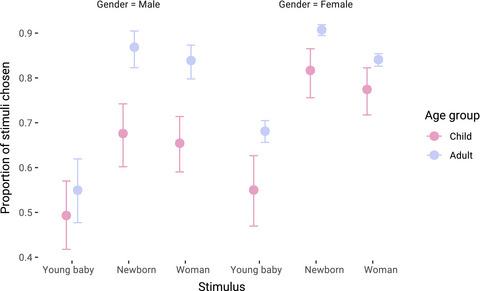Our official English website, www.x-mol.net, welcomes your
feedback! (Note: you will need to create a separate account there.)
Children aged 7–9 prefer cuteness in baby faces, and femininity in women's faces
Ethology ( IF 1.3 ) Pub Date : 2020-07-23 , DOI: 10.1111/eth.13081 Tamsin K. Saxton 1 , Thomas V. Pollet 1 , Jenny Panagakis 1 , Emily K. Round 1 , Samantha E. Brown 1 , Janek S. Lobmaier 2
Ethology ( IF 1.3 ) Pub Date : 2020-07-23 , DOI: 10.1111/eth.13081 Tamsin K. Saxton 1 , Thomas V. Pollet 1 , Jenny Panagakis 1 , Emily K. Round 1 , Samantha E. Brown 1 , Janek S. Lobmaier 2
Affiliation

|
Infant facial features are typically perceived as “cute,” provoking caretaking behaviours. Previous research has focused on adults' perceptions of baby cuteness, and examined how these perceptions are influenced by events of the adult reproductive lifespan, such as ovulation and menopause. However, globally, individuals of all ages, including pre‐pubertal children, provide notable proportions of infant care. In this study, we recruited participants in and around northern England, and tested 330 adults and 65 children aged 7–9 using a forced‐choice paradigm to assess preferences for infant facial cuteness in two stimulus sets and (as a control task) preferences for femininity in women's faces. We analysed the data with Hierarchical Bayesian Regression Models. The adults and children successfully identified infants who had been manipulated to appear cuter, although children's performance was poorer than adults' performance, and children reliably identified infant cuteness in only one of the two infant stimuli sets. Children chose the feminised over masculinised women's faces as more attractive, although again their performance was poorer than adults' performance. There was evidence for a female advantage in the tasks: girls performed better than boys when assessing the woman stimuli and one of the infant stimulus sets, and women performed better than men when assessing one of the infant stimulus sets. There was no evidence that cuteness judgements differed depending upon exposure to infants (children with siblings aged 0–2; adults with a baby caregiving role), or depending upon being just younger or older than the average age of menopause. Children and grandparents provide notable portions of infant caretaking globally, and cuteness perceptions could direct appropriate caregiving behaviour in these age groups, as well as in adults of reproductive age.
中文翻译:

7-9岁的孩子更喜欢娃娃脸的可爱和女人的脸庞
婴儿面部特征通常被认为是“可爱的”,会引起照顾行为。以前的研究集中在成年人对婴儿可爱的看法上,并研究了这些看法如何受到成年人生殖寿命事件的影响,例如排卵和更年期。然而,在全球范围内,所有年龄段的人,包括青春期前的儿童,都提供了显着比例的婴儿护理。在这项研究中,我们在英格兰北部及周边地区招募了参与者,并使用强制选择范式测试了 330 名成人和 65 名 7-9 岁儿童,以评估两种刺激组中婴儿面部可爱的偏好和(作为控制任务)女性脸上的女性气质。我们使用分层贝叶斯回归模型分析了数据。成人和儿童成功识别出被操纵以显得更可爱的婴儿,尽管儿童的表现比成人差,而且儿童仅在两个婴儿刺激组中的一个中可靠地识别出婴儿的可爱。孩子们认为女性化的女性面孔比男性化女性的面孔更具吸引力,尽管她们的表现再次比成人差。有证据表明女性在这些任务中具有优势:在评估女性刺激和一组婴儿刺激时,女孩的表现优于男孩,而在评估一组婴儿刺激时,女性的表现优于男性。没有证据表明可爱度判断因接触婴儿而异(有 0-2 岁兄弟姐妹的儿童;有照顾婴儿角色的成年人),或取决于比更年期的平均年龄更年轻或更年长。儿童和祖父母在全球范围内提供婴儿护理的显着部分,可爱感可以指导这些年龄组以及育龄成年人的适当护理行为。
更新日期:2020-07-23
中文翻译:

7-9岁的孩子更喜欢娃娃脸的可爱和女人的脸庞
婴儿面部特征通常被认为是“可爱的”,会引起照顾行为。以前的研究集中在成年人对婴儿可爱的看法上,并研究了这些看法如何受到成年人生殖寿命事件的影响,例如排卵和更年期。然而,在全球范围内,所有年龄段的人,包括青春期前的儿童,都提供了显着比例的婴儿护理。在这项研究中,我们在英格兰北部及周边地区招募了参与者,并使用强制选择范式测试了 330 名成人和 65 名 7-9 岁儿童,以评估两种刺激组中婴儿面部可爱的偏好和(作为控制任务)女性脸上的女性气质。我们使用分层贝叶斯回归模型分析了数据。成人和儿童成功识别出被操纵以显得更可爱的婴儿,尽管儿童的表现比成人差,而且儿童仅在两个婴儿刺激组中的一个中可靠地识别出婴儿的可爱。孩子们认为女性化的女性面孔比男性化女性的面孔更具吸引力,尽管她们的表现再次比成人差。有证据表明女性在这些任务中具有优势:在评估女性刺激和一组婴儿刺激时,女孩的表现优于男孩,而在评估一组婴儿刺激时,女性的表现优于男性。没有证据表明可爱度判断因接触婴儿而异(有 0-2 岁兄弟姐妹的儿童;有照顾婴儿角色的成年人),或取决于比更年期的平均年龄更年轻或更年长。儿童和祖父母在全球范围内提供婴儿护理的显着部分,可爱感可以指导这些年龄组以及育龄成年人的适当护理行为。











































 京公网安备 11010802027423号
京公网安备 11010802027423号